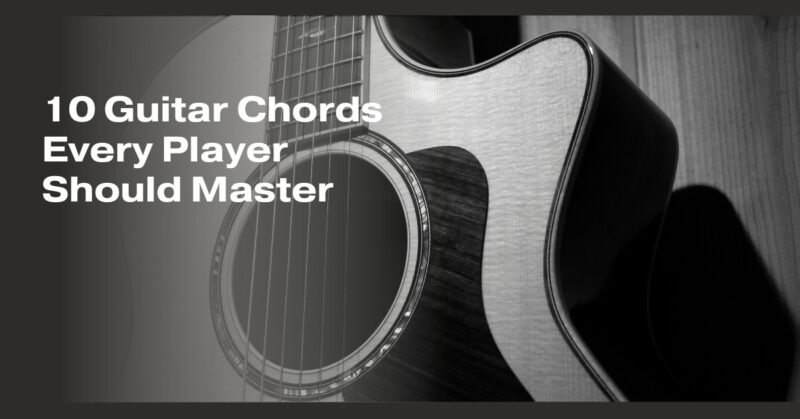Mastering essential guitar chords is crucial for any guitarist, whether you’re a beginner or an experienced player. These foundational chords serve as the building blocks for countless songs and are essential for developing your overall guitar skills. Here are 10 guitar chords that every player should master:
- Open E Major (E):
- Place your fingers on the 1st fret of the G string, 2nd fret of the A string, and 2nd fret of the D string. Strum all the strings except the low E.
- Open A Major (A):
- Place your fingers on the 2nd fret of the D, G, and B strings. Strum from the A string downward.
- Open D Major (D):
- Put your fingers on the 2nd fret of the G, B, and high E strings. Strum from the D string down to the high E.
- Open G Major (G):
- Place your fingers on the 2nd fret of the A string, 3rd fret of the low E string, and 3rd fret of the high E string. Strum all the strings, avoiding the low E.
- Open C Major (C):
- Form a C shape by placing your fingers on the 1st fret of the B string, 2nd fret of the D string, and 3rd fret of the A string. Strum from the A string down to the high E.
- Open E Minor (Em):
- Similar to the open E major, but remove your 1st finger from the 1st fret of the G string. Strum all strings except the low E.
- Open A Minor (Am):
- Place your fingers on the 2nd fret of the D and G strings. Strum from the A string downward.
- Open D Minor (Dm):
- Put your fingers on the 1st fret of the high E string and 3rd fret of the B string. Strum from the D string to the high E.
- Open G7 (G7):
- Form a G chord, but lift your pinky finger off the high E string. Strum all the strings, avoiding the low E.
- Open E7 (E7):
- Place your fingers on the 1st fret of the G string and 2nd fret of the A string. Strum all the strings, avoiding the low E.
These 10 chords provide a solid foundation for playing a wide range of songs in various genres, from folk to rock to pop. As you become proficient with these chords, you’ll find it easier to learn more complex chord shapes and expand your musical repertoire. Remember to practice regularly, work on your chord transitions, and maintain proper finger positioning to become a well-rounded guitarist.


